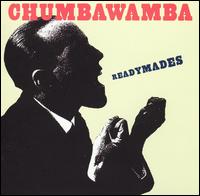Top Qs
Timeline
Chat
Perspective
Readymades (album)
2002 studio album by Chumbawamba From Wikipedia, the free encyclopedia
Remove ads
Readymades is the tenth studio album by Chumbawamba.[6] It also features vocal samples from contemporary and traditional folk artists, some of whom Chumbawamba would go on to work with in the future. The album's title refers to the use of everyday objects as art by Marcel Duchamp.
The album's artwork pays a homage to the I Have Nothing to Say And I'm Saying It poster designed by Alan Fletcher, which was in turn a self-portrait of German Dadaist John Heartfield (born Helmut Herzfelde).
Remove ads
Critical reception
The album was met with mixed reviews from critics. Writing for AllMusic, critic Michael Gallucci awarded the album three stars out of five; Gallucci praised the album's consistency and noted that it "basically follows the pattern laid out on their previous two albums," adding that "the pop is a little more forward, as is the political theorizing."[2] Music critic Robert Christgau dismissed the album as containing "faux-slick truths about real world horror", singling out "All in Vain" and "Don't Pass Go" as highlights.[4] The album holds a rating of one and a half stars in the Rolling Stone Album Guide, which called the album "skippable" and commented that it was "a vacant, hookless dud: folk song samples and bland singing pasted onto prefab dance grooves."[5]
Remove ads
Release
The album was released on 18 June 2002.[2] A special version of the album, Readymades And Then Some was released in 2003. It came with bonus track–peace anthem "Jacob's Ladder (Not in My Name)" and a bonus DVD.[7]
Track listing
Summarize
Perspective
All tracks written, arranged and produced by Chumbawamba, except where noted.
Remove ads
Album detail
In a statement on their website, Chumbawamba stated that "When we decided to mimic Moby's sampling of traditional black American blues singers on his album Play, we turned to British folk music and its great voices. Kate Rusby, Dick Gaughan, Coope, Boyes & Simpson, Harry Cox. Our album Readymades was put together in a skewed homage to some of those voices. We half expected criticism from the folk world for messing around with the music, but found that the folk audience is assuredly open to change and diversity. Since then – even in the last four or five years – the modern folk voices and players have multiplied and expanded, folkies are looking younger and cooler and there are loads of new folk albums out every month. Good or bad, the music's often inspiring and exciting. That there's still a radical voice in folk music (and especially in its audience) makes it easy for us to write and play the way we're doing right now. Trying to be part of a radical tradition that, for us, encompasses our own histories (mostly northern working towns, The Beatles and punk rock!) and the history of rebel songs in the places we've lived."[11]
Remove ads
Personnel
- Jude Abbott – Trumpet, vocals
- Dunstan Bruce – Vocals, bruitist sound collages
- Lou Watts – Vocals, keyboards
- Boff Whalley – Guitar, merz
- Neil Ferguson – Bass, mouse
- Alice Nutter – Vocals, propaganda
- Harry Hamer – Drums, programming
- Danbert Nobacon – Vocals, ukulele
with
- Simon Pugsley – Trombone
- Toby Greenwood – Saxophone
- Rrose Selavy – Acoustic guitar
- James Reiss – Scratching
- Richard Mutt – Tea-chest bass
- Michelle Plum (credited as Michelle Plumb), Abi Riozzi, Sally Riozzi & Janet Russell – vocals
Remove ads
References
Wikiwand - on
Seamless Wikipedia browsing. On steroids.
Remove ads

